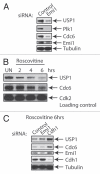Insights into phosphorylation-dependent mechanisms regulating USP1 protein stability during the cell cycle
- PMID: 22101265
- PMCID: PMC3272283
- DOI: 10.4161/cc.10.23.18501
Insights into phosphorylation-dependent mechanisms regulating USP1 protein stability during the cell cycle
Abstract
Tight regulation of the cell cycle and DNA repair machinery is essential for maintaining genome stability. The APC/CCdh1 ubiquitin ligase complex is a key regulator of protein stability during the G 1 phase of the cell cycle. APC/CCdh1 regulates and promotes the degradation of proteins involved in both cell cycle regulation and DNA repair. In a recent study, we identified a novel APC/CCdh1 substrate, the ubiquitin protease USP1. USP1 is a critical regulator of both the Fanconi anemia (FA) and translesion synthesis (TLS) DNA repair pathways. Here, we provide additional mechanistic insights into the regulation of USP1 during the cell cycle. Specifically, we demonstrate that USP1 is phosphorylated in mitosis by cyclin-dependent kinases (Cdks), and that this phosphorylation event may prevent premature degradation of USP1 during normal cell cycle progression. Finally, we provide a unifying hypothesis integrating the role of G 1-specific proteolysis of USP1 with the regulation of the transcriptional repressors, Inhibitor of DNA-binding (ID) proteins.
Figures




Similar articles
-
APC/CCdh1-dependent proteolysis of USP1 regulates the response to UV-mediated DNA damage.J Cell Biol. 2011 Jul 25;194(2):177-86. doi: 10.1083/jcb.201101062. Epub 2011 Jul 18. J Cell Biol. 2011. PMID: 21768287 Free PMC article.
-
CAPNS1 regulates USP1 stability and maintenance of genome integrity.Mol Cell Biol. 2013 Jun;33(12):2485-96. doi: 10.1128/MCB.01406-12. Epub 2013 Apr 15. Mol Cell Biol. 2013. PMID: 23589330 Free PMC article.
-
The deubiquitinating enzyme USP1 regulates the Fanconi anemia pathway.Mol Cell. 2005 Feb 4;17(3):331-9. doi: 10.1016/j.molcel.2005.01.008. Mol Cell. 2005. PMID: 15694335
-
USP1 deubiquitinase: cellular functions, regulatory mechanisms and emerging potential as target in cancer therapy.Mol Cancer. 2013 Aug 10;12:91. doi: 10.1186/1476-4598-12-91. Mol Cancer. 2013. PMID: 23937906 Free PMC article. Review.
-
USP1 in regulation of DNA repair pathways.DNA Repair (Amst). 2025 Feb;146:103807. doi: 10.1016/j.dnarep.2025.103807. Epub 2025 Jan 15. DNA Repair (Amst). 2025. PMID: 39848025 Review.
Cited by
-
Deubiquitinating enzymes as oncotargets.Oncotarget. 2015;6(12):9657-68. doi: 10.18632/oncotarget.3922. Oncotarget. 2015. PMID: 25962961 Free PMC article. Review.
-
Opportunities to advance cervical cancer prevention and care.Tumour Virus Res. 2024 Dec;18:200292. doi: 10.1016/j.tvr.2024.200292. Epub 2024 Oct 25. Tumour Virus Res. 2024. PMID: 39490532 Free PMC article. Review.
-
Monitoring Target Engagement of Deubiquitylating Enzymes Using Activity Probes: Past, Present, and Future.Methods Mol Biol. 2016;1449:395-410. doi: 10.1007/978-1-4939-3756-1_26. Methods Mol Biol. 2016. PMID: 27613052 Free PMC article.
-
Eukaryotic Translesion DNA Synthesis on the Leading and Lagging Strands: Unique Detours around the Same Obstacle.Chem Rev. 2017 Jun 28;117(12):7857-7877. doi: 10.1021/acs.chemrev.7b00046. Epub 2017 May 12. Chem Rev. 2017. PMID: 28497687 Free PMC article. Review.
-
AKT and DUBs: a bidirectional relationship.Cell Mol Biol Lett. 2025 Jul 7;30(1):77. doi: 10.1186/s11658-025-00753-3. Cell Mol Biol Lett. 2025. PMID: 40624457 Free PMC article. Review.
References
Publication types
MeSH terms
Substances
Grants and funding
LinkOut - more resources
Full Text Sources
Miscellaneous
